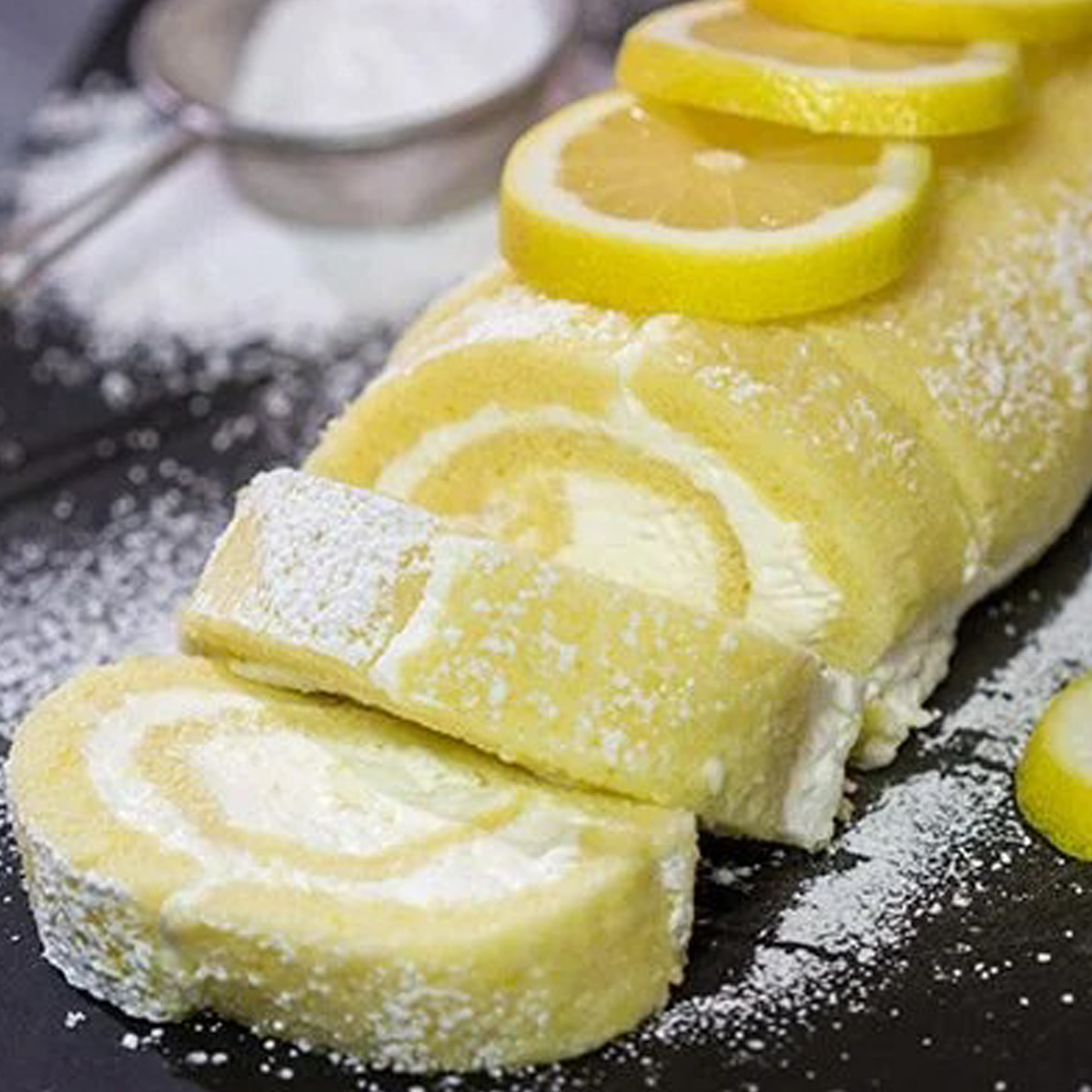Lemon Pound Cake, with its bright citrusy flavor and dense, tender crumb, is a classic dessert that never goes out of style. This timeless confection is a delightful blend of simplicity and indulgence, perfect for any occasion, from afternoon tea to elegant celebrations.
The essence of Lemon Pound Cake lies in its name: the rich, buttery pound cake is infused with the zesty brightness of fresh lemons, creating a harmonious balance of sweet and tangy flavors. Each bite offers a burst of sunshine, making it a favorite among those who appreciate the refreshing and comforting qualities of citrus desserts.
In this introduction, we’ll embark on a journey into the world of Lemon Pound Cake, exploring its history, the secrets behind its moist and tender crumb, and the numerous ways to enjoy this beloved treat. Whether served plain, glazed, or with a scoop of vanilla ice cream, Lemon Pound Cake is a testament to the timeless appeal of simple, flavorful baking.

What Is Lemon Pound Cake?
Lemon Pound Cake is a classic dessert known for its dense and buttery texture, infused with the vibrant flavor of fresh lemons. This delightful cake gets its name from its traditional recipe, which originally called for a pound each of four main ingredients: butter, sugar, eggs, and flour. While modern variations may deviate from these exact measurements, the essence of a pound cake remains intact.
Here are the key characteristics of Lemon Pound Cake:
1. Flavor: Lemon Pound Cake is celebrated for its prominent lemon flavor. This is achieved by incorporating fresh lemon zest and juice into the batter, resulting in a tangy and citrusy profile that perfectly complements the rich, buttery base.
2. Texture: The texture of Lemon Pound Cake is dense and moist, with a fine crumb that almost melts in your mouth. It’s achieved through the use of ample butter and eggs in the recipe.
3. Versatility: While Lemon Pound Cake can be enjoyed on its own as a simple yet satisfying dessert, it also serves as a versatile base for creativity. It can be served plain, dusted with powdered sugar, glazed with a lemony icing, or even topped with berries or whipped cream for an extra touch of elegance.
4. Slices or Loaf: Lemon Pound Cake is typically baked in loaf form, making it easy to slice into individual servings. It’s a popular choice for afternoon tea, brunch, or as a dessert at gatherings.
5. Timelessness: This cake has a timeless appeal and has been cherished for generations. It embodies the idea of classic home baking and comfort food.
6. Variations: Lemon Pound Cake can be customized with different variations, such as adding poppy seeds for a Lemon Poppy Seed Pound Cake or incorporating other citrus fruits like oranges or limes for unique flavor profiles.
Overall, Lemon Pound Cake is a beloved dessert that captures the essence of citrusy freshness and comforting sweetness. Its simplicity and versatility make it a favorite for both casual and special occasions.

Why You Will Love Lemon Pound Cake Recipe?
1. Vibrant Lemon Flavor: A well-crafted Lemon Pound Cake is bursting with the zesty, bright, and refreshing flavor of fresh lemons. It’s like a slice of sunshine on your plate, making it perfect for those who appreciate citrusy delights.
2. Irresistible Texture: Lemon Pound Cake is celebrated for its dense yet incredibly tender and moist crumb. Every bite is a luxurious experience that melts in your mouth, leaving you craving more.
3. Versatile Dessert: This cake is a versatile canvas for creativity. Enjoy it plain for a simple treat, or explore various ways to enhance its flavor and presentation, such as with a lemon glaze, powdered sugar, fresh berries, or a dollop of whipped cream.
4. Time-Tested Classic: Lemon Pound Cake is a timeless classic that has stood the test of time. It carries the charm of traditional home baking, making it a comforting and familiar dessert choice.
5. Easy to Make: While it may sound fancy, Lemon Pound Cake is relatively simple to prepare. Even novice bakers can achieve impressive results with the right recipe and a few basic baking techniques.
6. Perfect for Any Occasion: Whether you’re hosting a tea party, celebrating a special occasion, or simply treating yourself, Lemon Pound Cake is suitable for a wide range of events and settings.
7. Customization Options: You can personalize your Lemon Pound Cake by adding variations like poppy seeds, different citrus fruits, or even a drizzle of lemon syrup for added depth of flavor.
8. Wonderful Aroma: As the Lemon Pound Cake bakes, your kitchen will be filled with the irresistible aroma of citrus and butter, making it a delightful sensory experience.
9. Nostalgic Comfort: Lemon Pound Cake often evokes feelings of nostalgia and comfort, reminding many of cherished family recipes and warm gatherings.
10. Crowd-Pleaser: Its universal appeal ensures that Lemon Pound Cake is a dessert that can please a wide range of tastes and preferences, making it an excellent choice for sharing with family and friends.
In summary, a well-executed Lemon Pound Cake recipe promises a symphony of lemony delight, a melt-in-your-mouth texture, and the flexibility to be tailored to your preferences. It’s a dessert that combines simplicity and elegance, making it a favorite among both seasoned bakers and those looking to explore the world of homemade treats.

Ingredients For Lemon Pound Cake
For the Lemon Pound Cake:
- 1 cup (2 sticks or 226 grams) unsalted butter, softened
- 2 cups (400 grams) granulated sugar
- 4 large eggs, at room temperature
- 2 1/2 cups (300 grams) all-purpose flour
- 1/2 teaspoon baking powder
- 1/2 teaspoon baking soda
- 1/2 teaspoon salt
- 1/2 cup (120 ml) freshly squeezed lemon juice
- 2 tablespoons lemon zest (from about 2 lemons)
- 1 teaspoon pure vanilla extract
- 1/2 cup (120 ml) buttermilk, at room temperature
For the Lemon Glaze (Optional):
- 1 cup (120 grams) powdered sugar (confectioners’ sugar)
- 2-3 tablespoons freshly squeezed lemon juice
- Additional lemon zest for garnish (optional)
Please note that these quantities are based on a standard Lemon Pound Cake recipe. You can adjust the lemon juice and zest to suit your taste preferences, whether you prefer a more intense lemon flavor or a milder citrus note. Additionally, the lemon glaze is optional, but it adds an extra layer of lemony sweetness and a beautiful shine to the cake.
Before starting, ensure that all your ingredients are measured accurately, and you have all your equipment ready for baking this delightful Lemon Pound Cake.
How To Make Lemon Pound Cake
For the Lemon Pound Cake:
Preparing the Batter:
- Preheat your oven to 350°F (175°C). Grease and flour a standard 10-inch (25 cm) bundt pan or a loaf pan. Set it aside.
- In a medium-sized bowl, whisk together 2 1/2 cups of all-purpose flour, 1/2 teaspoon of baking powder, 1/2 teaspoon of baking soda, and 1/2 teaspoon of salt. Set this dry ingredient mixture aside.
- In a separate large mixing bowl, cream 1 cup of softened unsalted butter with 2 cups of granulated sugar until the mixture is light and fluffy. This can take about 3-5 minutes.
- Add 4 large eggs, one at a time, beating well after each addition. Make sure the eggs are at room temperature for even mixing.
- Stir in 2 tablespoons of lemon zest and 1 teaspoon of pure vanilla extract for a burst of lemony flavor and a touch of vanilla sweetness.
- Gradually add the dry ingredient mixture to the wet ingredients in the large bowl, alternating with 1/2 cup of buttermilk. Begin and end with the dry ingredients. Mix until just combined; avoid overmixing.
- Pour in 1/2 cup of freshly squeezed lemon juice and gently fold it into the batter. The lemon juice adds the perfect citrusy brightness.
Baking the Cake:
- Pour the batter into the prepared bundt or loaf pan, smoothing the top.
- Bake in the preheated oven for approximately 45-55 minutes, or until a toothpick or cake tester inserted into the center comes out clean with just a few moist crumbs clinging to it.
- Remove the cake from the oven and allow it to cool in the pan for about 10-15 minutes.
- After the initial cooling period, invert the cake onto a wire rack to cool completely.
For the Lemon Glaze (Optional):
- In a small bowl, combine 1 cup of powdered sugar with 2-3 tablespoons of freshly squeezed lemon juice. Adjust the amount of lemon juice to achieve your desired glaze consistency—thicker for a drizzle, thinner for a more translucent glaze.
- Once the cake has cooled completely, drizzle the lemon glaze over the top, allowing it to flow down the sides of the cake for a beautiful finish.
Additional Lemon Zest Garnish (Optional):
- For an extra touch of lemony zest, sprinkle additional lemon zest on top of the glaze.
Serve and Enjoy:
- Once the glaze has set, slice and serve your homemade Lemon Pound Cake. Each bite will be a delightful burst of lemony goodness.
This Lemon Pound Cake is a true crowd-pleaser, perfect for various occasions or simply as a sweet treat to enjoy with a cup of tea or coffee.

How To Serve Lemon Pound Cake
Serving Lemon Pound Cake is a delightful experience, and there are various ways to enjoy this classic dessert. Here’s how to serve Lemon Pound Cake:
1. Plain and Simple:
- Serve slices of Lemon Pound Cake on their own. This allows the natural citrusy flavor and buttery richness to shine.
2. Lemon Glaze:
- Drizzle the cake slices with a lemon glaze made from powdered sugar and freshly squeezed lemon juice for an extra burst of lemony sweetness.
3. Whipped Cream:
- Accompany each slice with a dollop of freshly whipped cream. The combination of the creamy topping and zesty cake is heavenly.
4. Berries and Fruit:
- Garnish with fresh berries like strawberries, raspberries, or blueberries. The vibrant colors and fruity flavors complement the cake beautifully.
5. Vanilla Ice Cream:
- Serve Lemon Pound Cake warm with a scoop of high-quality vanilla ice cream for a comforting and indulgent dessert.
6. Tea or Coffee:
- Lemon Pound Cake pairs wonderfully with a cup of tea or coffee. The citrusy notes complement the beverages’ flavors.
7. Brunch or Tea Party:
- Lemon Pound Cake is a fantastic addition to brunch or tea parties. Offer it alongside a selection of teas or coffee for a delightful gathering.
8. Special Occasions:
- For celebrations, consider serving Lemon Pound Cake as part of a dessert buffet or alongside other treats like fruit salad, macarons, or petit fours.
9. Toasted or Grilled:
- For a unique twist, lightly toast or grill slices of Lemon Pound Cake to add a caramelized, crispy texture. It’s a delightful contrast to the soft cake interior.
10. Presentation:
- Arrange the cake slices on a decorative platter or individual dessert plates to elevate the presentation.
11. Individual Portions:
- If you’re serving Lemon Pound Cake at an event, consider pre-slicing it into individual portions for convenience.
12. Lemon Zest Garnish:
- Finish with a sprinkle of lemon zest on top of each slice for an extra touch of citrus aroma and visual appeal.
13. Dust with Powdered Sugar:
- A light dusting of powdered sugar on top of each slice adds a touch of elegance.
Whether you prefer it plain, with a glaze, or accompanied by complementary flavors, serving Lemon Pound Cake is all about savoring its delightful taste and making it a memorable treat for any occasion.

How To Store Lemon Pound Cake
Properly storing Lemon Pound Cake is crucial to maintain its freshness and flavor. Here are the steps to store Lemon Pound Cake:
1. Cool Completely: Allow the Lemon Pound Cake to cool completely at room temperature. This typically takes about 1-2 hours.
2. Wrap or Cover: Once the cake has cooled, wrap it tightly or cover it to prevent it from drying out and absorbing any odors from the surrounding environment. Here are a few options:
- Plastic Wrap: Wrap the entire cake in plastic wrap, ensuring it’s sealed tightly. You can also wrap individual slices for convenience.
- Aluminum Foil: Wrap the cake in aluminum foil, especially if you plan to freeze it.
- Cake Container: If you have a cake container with a secure lid, place the cake inside it. This is an excellent option for short-term storage.
3. Refrigeration: Lemon Pound Cake can be stored in the refrigerator to extend its shelf life. This is a good option if you plan to consume it within a week.
4. Freezing (Optional): If you want to store the cake for an extended period, you can freeze it. Here’s how:
- Wrap the cake tightly in plastic wrap or aluminum foil to prevent freezer burn.
- Place the wrapped cake in an airtight container or a resealable freezer bag for extra protection.
- Label the container or bag with the date to keep track of its freshness.
- Frozen Lemon Pound Cake can be stored for up to 2-3 months.
5. Room Temperature: If you plan to consume the cake within a day or two and the ambient temperature is cool, you can store it at room temperature. However, keep it in a cool, dry place away from direct sunlight and heat sources.
6. Slices: If you’ve sliced the cake and want to keep individual slices fresh, wrap them in plastic wrap or place them in airtight containers. This makes it easy to grab a slice when you crave it.
7. Moisture Absorbent: To prevent moisture buildup in the storage container or bag, you can add a food-safe silica gel packet or a piece of dry bread. Just make sure the bread doesn’t come into direct contact with the cake.
8. Separate Layers: If you’re stacking slices or multiple cake layers, place parchment paper between each layer to prevent sticking.
9. Room Temperature Serving: When you’re ready to enjoy the cake, let it come to room temperature for about 10-15 minutes. This allows it to regain its full flavor and texture.
Properly stored, Lemon Pound Cake can stay fresh and delicious for several days, or even months if frozen. Whether it’s a homemade treat or store-bought, these storage tips will help you enjoy Lemon Pound Cake at its best.
Other Delicious Dessert Recipes To Try
- Lemon Cake
- Lemon Buttermilk Cake
- Lemon Zucchini Cake
- Lemon Cream Cake
- Lemon Cupcakes
- Lemon Sponge Cake
Tips And Tricks For Lemon Pound Cake
Baking the perfect Lemon Pound Cake requires attention to detail and some helpful tips and tricks. Here are some to ensure your Lemon Pound Cake turns out wonderfully:
1. Use Fresh Lemons: For the best lemon flavor, always use fresh lemons for both the juice and zest. Avoid bottled lemon juice or dried zest, as they won’t provide the same vibrant taste.
2. Room Temperature Ingredients: Ensure that your eggs and buttermilk are at room temperature. This helps with proper mixing and ensures a more even texture in the cake.
3. Cream the Butter and Sugar: Cream the softened butter and sugar together for a good 3-5 minutes. This process aerates the mixture and helps create a tender crumb in your cake.
4. Gradually Add Eggs: Add the eggs one at a time, beating well after each addition. This ensures they are fully incorporated and contributes to a smoother batter.
5. Sift Dry Ingredients: Sift your dry ingredients, such as flour, baking powder, baking soda, and salt, before adding them to the wet ingredients. This prevents lumps and ensures even distribution.
6. Fold Gently: When adding the dry ingredients to the wet ingredients, use a gentle folding technique with a spatula. Overmixing can lead to a denser cake.
7. Don’t Overbake: Be vigilant about the baking time. Overbaking can result in a dry cake. Test for doneness with a toothpick or cake tester; it should come out with just a few moist crumbs.
8. Lemon Zest and Juice: Use both lemon zest and lemon juice for a balanced lemon flavor. The zest provides aromatic oils that enhance the taste.
9. Buttermilk for Moisture: Buttermilk adds moisture and a subtle tangy flavor. If you don’t have buttermilk, you can make a substitute by adding 1 tablespoon of lemon juice or vinegar to 1/2 cup of milk and letting it sit for a few minutes before using.
10. Grease and Flour Properly: Ensure your baking pan is thoroughly greased and floured to prevent the cake from sticking.
11. Let it Cool: Allow the cake to cool in the pan for about 10-15 minutes before transferring it to a wire rack to cool completely. This prevents it from breaking apart.
12. Lemon Glaze: If you choose to add a lemon glaze, do it when the cake has cooled to room temperature but is still slightly warm. This allows the glaze to soak in without sliding off.
13. Storage: Properly store the cake to maintain its freshness. Use plastic wrap, aluminum foil, or a cake container. If freezing, use airtight containers or bags.
14. Room Temperature Serving: Lemon Pound Cake is best enjoyed at room temperature as it allows the flavors to fully develop.
15. Experiment: Don’t be afraid to experiment with variations. You can add poppy seeds for Lemon Poppy Seed Pound Cake or incorporate other citrus fruits for different flavors.
With these tips and a little practice, you’ll be baking perfect Lemon Pound Cakes that are bursting with lemony goodness and have a wonderfully tender crumb.

FAQs And Troubleshooting
FAQs:
Why is my Lemon Pound Cake dry or crumbly?
- Overbaking can lead to a dry cake. Make sure to follow the recommended baking time and test for doneness with a toothpick or cake tester.
Can I use bottled lemon juice instead of fresh lemon juice?
- While fresh lemon juice is preferred for the best flavor, you can use bottled lemon juice in a pinch. However, fresh lemon juice will provide a more vibrant citrus taste.
How do I prevent my cake from sticking to the pan?
- Properly grease and flour your baking pan to prevent sticking. You can also use parchment paper to line the bottom of the pan for easy removal.
What should I do if my cake is browning too quickly on top?
- If your cake is browning too quickly but is not fully baked, you can tent it with aluminum foil to prevent further browning while it continues to bake.
Can I make Lemon Pound Cake without a bundt pan?
- Yes, you can use other types of cake pans, such as loaf pans or round cake pans. Adjust the baking time accordingly based on the size and depth of the pan you choose.
Troubleshooting:
- Dense Cake: If your cake turns out too dense, it may be due to overmixing the batter. Be gentle when folding the dry ingredients into the wet ones.
- Sunken Center: A sunken center can result from underbaking. Ensure you follow the recommended baking time and use a toothpick or cake tester to check for doneness.
- Cracked Top: If your cake has a cracked top, it may have risen too quickly in the oven. To prevent this, avoid overbeating the batter and ensure your oven temperature is accurate.
- Tangy Buttermilk: If you find that your buttermilk is too tangy, you can reduce the tanginess by using a mixture of regular milk and yogurt instead.
- Glaze Not Setting: If the lemon glaze isn’t setting properly, it may be too thin. Add more powdered sugar to thicken it, or allow it more time to set.
- Sinking Fruit: If you’re adding berries or other fruit to your cake, they can sink to the bottom during baking. To prevent this, toss them in a bit of flour before folding them into the batter.
- Dry Edges: Dry edges can occur if the cake is overbaked. To avoid this, use an oven thermometer to ensure your oven temperature is accurate, and monitor the baking time closely.
Remember that baking can be a bit finicky, and it may take some practice to achieve the perfect Lemon Pound Cake. If you encounter issues, don’t be discouraged; use these troubleshooting tips to improve your baking skills and enjoy delicious Lemon Pound Cake.
Nutrition Information
Here is a rough estimate of the nutrition information for a standard slice (about 1/12th of a 10-inch bundt cake) of Lemon Pound Cake, including the optional lemon glaze:
Calories: Approximately 250-300 calories per slice, depending on the size and specific recipe, Total Fat: About 12-15 grams per slice, Saturated Fat: Approximately 7-9 grams per slice. Carbohydrates: Around 33-40 grams per slice, Sugars: Roughly 22-28 grams per slice, with the glaze, Protein: Approximately 3-5 grams per slice, Fiber: Minimal fiber content, usually less than 1 gram per slice, Cholesterol: About 70-90 milligrams per slice, Sodium: Around 150-200 milligrams per slice.
Please note that these values are approximate and can vary based on the specific recipe, portion size, and whether or not you include the optional lemon glaze. Homemade recipes may also differ in their ingredients and nutrition content. If you have specific dietary concerns or are using a particular recipe, it’s best to calculate the exact nutrition information based on the ingredients and quantities you use.





